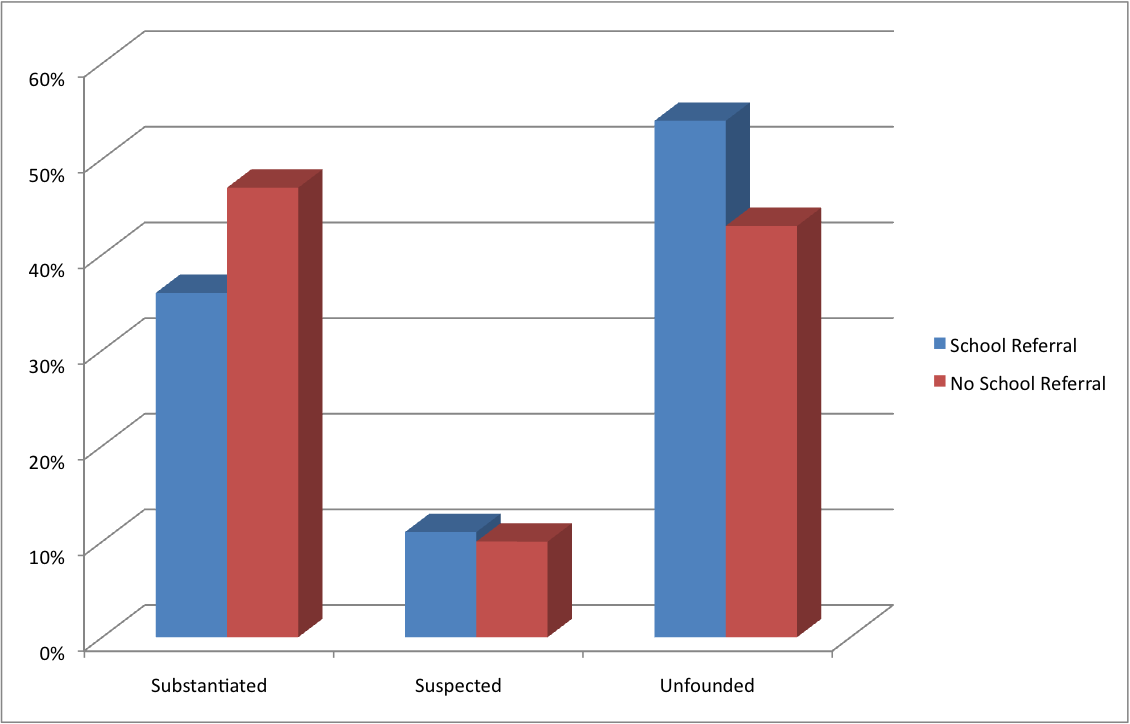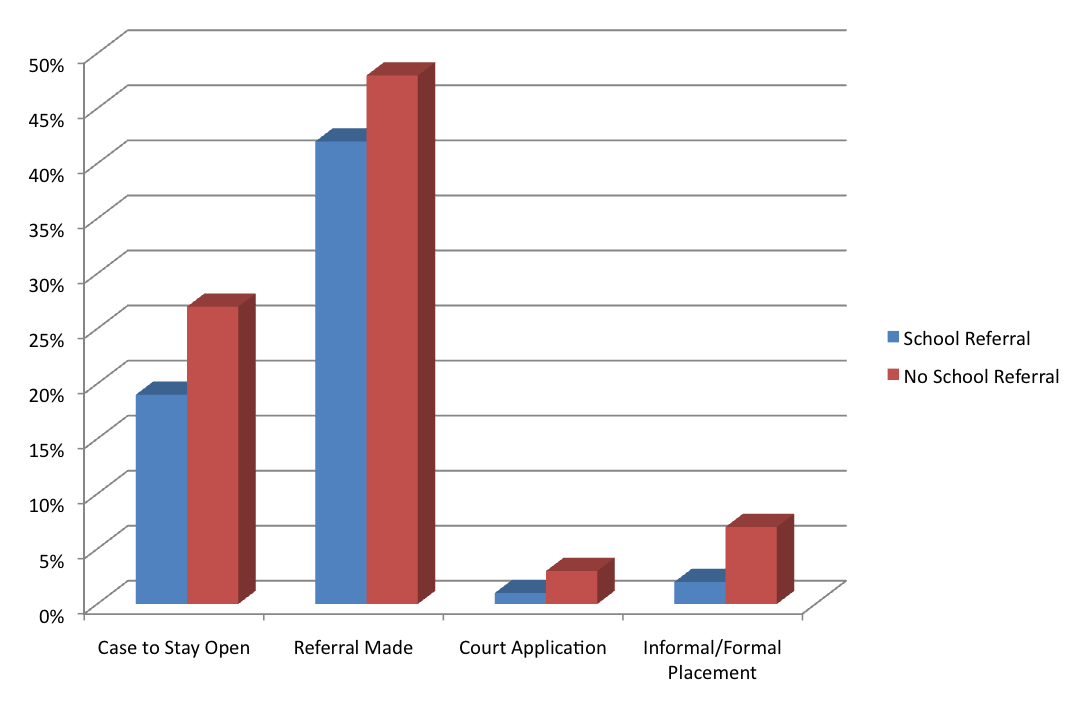Ma, J., Van Wert, M., Smith, C., & Fallon, B. (2012). OIS-2008: Examination of Investigations Referred to Child Welfare Authorities by Schools. Canadian Child Welfare Research Portal: Toronto, ON.
Introduction
The Ontario Incidence Study of Reported Child Abuse and Neglect, 2008 (OIS-2008) is the fourth provincial study to examine the incidence of reported child maltreatment and the characteristics of children and families investigated by child welfare authorities in Ontario. This fact sheet will examine the profile of investigations in which any school personnel (i.e. teacher, principal, teacher’s aide, school social worker, etc.) made the referral to child welfare authorities.
Background to the OIS-2008
From 1998 to 2003, the OIS found that rates of investigated maltreatment had doubled. This pattern may reflect changes in detection, reporting, and investigation practices rather than an increase in the number of children being abused and neglected. Four changes are particularly important to consider: increased reporting by professionals, increased reports of emotional maltreatment and exposure to intimate partner violence, more children investigated in each family, and increased substantiation rates. These changes are consistent with shifts in the context of Ontario child welfare.
Due to changes in investigation mandates and practices over the last 10 years, the OIS-2008 differed from previous cycles in that it tracked both risk-only investigations and maltreatment investigations. Risk-only investigations were those in which a specific past incident of maltreatment was not suspected or alleged to have occurred, but rather a constellation of factors lead to concerns that a child may be maltreated in the future (e.g., caregiver with a substance misuse issue).
Methodology
The OIS-2008 used a multi-stage sampling design to select a representative sample of 23 child welfare agencies in Ontario and then to select a sample of cases within these agencies. Information was collected directly from child protection workers on a representative sample of 7,471 child protection investigations conducted during a three-month sampling period in 2008. This sample was weighted to reflect provincial annual estimates.
Workers were asked to indicate all of the sources of referral applicable to each case. This referred to separate and independent contacts with the child welfare agency. Workers could endorse up to 19 separate referral sources, one of which was school personnel.
Select Comparisons of Investigations Referred by School Personnel and Investigations Referred by Other Sources
In 2008, an estimated 128,749 maltreatment-related investigations were conducted in Ontario. Of these investigations, an estimated 32,371 (25%) were referred to child welfare authorities by school personnel. In an estimated 96,377 investigations (75%), the case was not referred to child welfare authorities by school personnel but rather a different source (e.g., police, hospital, relative, etc.).
Figure 1 presents the types of investigations conducted across Ontario in 2008. In an estimated 22,622 (70%) investigations referred by school personnel, the case involved a maltreatment concern. In the remaining 30% of investigations (estimated 9,749), the case involved a risk assessment. For investigations referred by sources other than the school, the focus of the investigation was a maltreatment concern in an estimated 64,403 (67%) cases, and the focus was a risk assessment in 31,974 investigations (33%).
Figure 1: Type of child maltreatment investigations in Ontario in 2008

Figure 2 describes the primary category of maltreatment among investigations conducted in 2008. Of the estimated 22,622 maltreatment investigations referred by school personnel, the primary concern of the investigation was physical abuse in approximately 12,247 cases (54%), sexual abuse in 1,211 cases (5%), neglect in 5,832 cases (26%), emotional maltreatment in 1,808 cases (8%), and exposure to intimate partner violence in 1,523 cases (7%).
Of the estimated 64,403 maltreatment investigations referred by sources other than school personnel, the primary concern of the investigation was physical abuse in 10,814 cases (17%), sexual abuse in 3,433 cases (5%), neglect in 23,076 cases (36%), emotional maltreatment in 6,231 cases (10%), and exposure to intimate partner violence in 20,849 cases (32%).
Figure 2: Primary category of child maltreatment investigations in Ontario in 2008

Figure 3 describes substantiation decisions resulting from maltreatment investigations conducted across Ontario in 2008. Of the estimated 22,622 maltreatment investigations referred by school personnel, 8,054 investigations were substantiated (36%) by the investigating worker, 2,375 investigations were suspected (10%), and 12,193 investigations were unfounded (54%).
Figure 3: Level of substantiation of child maltreatment investigations in Ontario in 2008

Of the estimated 64,403 maltreatment investigations referred by sources other than school personnel, 30,517 investigations were substantiated (47%) by the investigating worker, 6,264 investigations were suspected (10%), and 27,621 investigations were unfounded (43%).
Figure 4 presents service disposition decisions resulting from maltreatment-related investigations (i.e., maltreatment and risk investigations) conducted across Ontario in 2008. Of the estimated 32,372 maltreatment-related investigations referred to child welfare authorities by school personnel, 6,078 (19%) were opened for ongoing service, and 13,517 (42%) received a referral to a service internal or external to the agency. A court application was made in 1% (estimated 342) of investigations referred by school personnel, and in an estimated 632 cases (2%), the investigation resulted in an informal or formal placement for the child.
Figure 4: Provision of services following child maltreatment-related investigations in Ontario in 2008

Of the estimated 96,377 maltreatment-related investigations referred to child welfare authorities by a source other than school personnel, 25,615 (27%) were opened for ongoing service, and 46,362 (48%) received a referral to a service internal or external to the agency. A court application was made in 3% (estimated 3,209) of investigations referred by school personnel, and in an estimated 6,680 cases (7%), the investigation resulted in an informal or formal placement for the child.
Figure 5 describes physical and mental or emotional harm for investigations conducted in Ontario in 2008. Of the 10,429 investigations referred by school personnel that were substantiated or suspected, physical harm to the child as a result of maltreatment was present in an estimated 2,125 (20%) cases, and mental or emotional harm was evident in 2,497 (24%) cases.
Of the 36,781 investigations referred by sources other than school personnel that were substantiated or suspected, physical harm to the child as a result of maltreatment was present in an estimated 2,890 (8%) cases, and mental or emotional harm was evident in 8,841 (23%) cases.
Figure 5: Physical harm and mental/emotional harm in child maltreatment-related investigations in Ontario in 2008

Overall, the maltreatment investigations referred by school personnel largely involved physical abuse. Among investigations referred by sources other than school personnel, the primary concern of most of the investigations was either neglect or exposure to intimate partner violence. Investigations referred by school personnel were less likely to be substantiated and less likely to result in ongoing services in comparison to investigations referred by other sources. Lastly, in comparison to investigations referred by sources other than school personnel that were substantiated or suspected, physical harm to the child as a result of maltreatment was present in more of the investigations referred by school personnel.
Limitations of the OIS-2008
The OIS-2008 does not include information about unreported maltreatment, or cases that were only investigated by police. Reports that were made to child welfare authorities but screened out before they were investigated are not included, and reports on cases currently open at the time of case selection are also not included. The study does not track longer service events that occur beyond the initial investigation.
